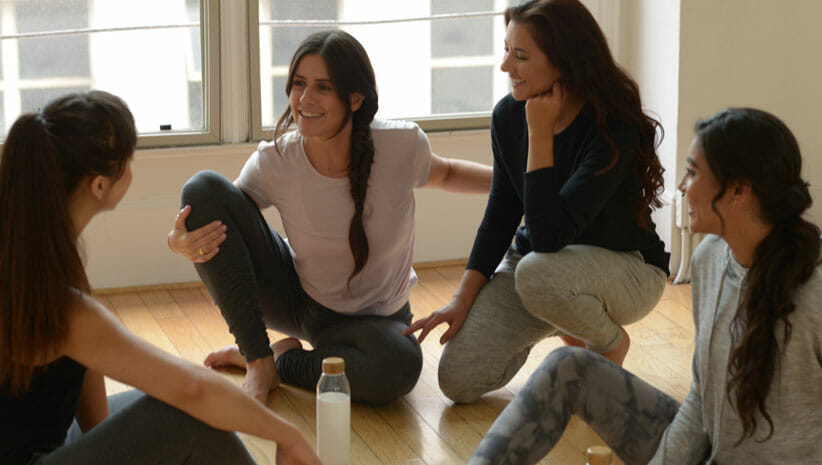
Sarah Ezrin and Students. Photo by Andy Blake.
Yoga Teachers Can Build Community in the Studio
We are in a time of great divide. How we act right now can either bring us closer together or send us further apart. It is easy to dig our heels into our respective corners and opinions, but it is much harder to reach across the aisle and see past our differences. Fortunately, there are sanctuaries where we can set aside our political and religious beliefs. Places where we can disrobe from the weight of our identities and come together on common ground – yoga. In yoga, we can find ways to build community with each and every practice.
The word yoga comes from the root word ‘yuj’, which means to unite or bind. People may think yoga means poses, but at its core, yoga is about uniting. It is where we learn to integrate all sides of our self: our body, breath, mind, and soul. Yoga is also where we can come to deeply understand that we are connected to all beings just as they are connected to us. It starts with breathing together and then, as we become more skillful about accessing the subtle, we start to literally sense each other’s energy as one.
As we become busier, we seem to be spending less time in yoga studios and classes. Still, students regularly remark to me that they wish there was more community. People are craving connection.
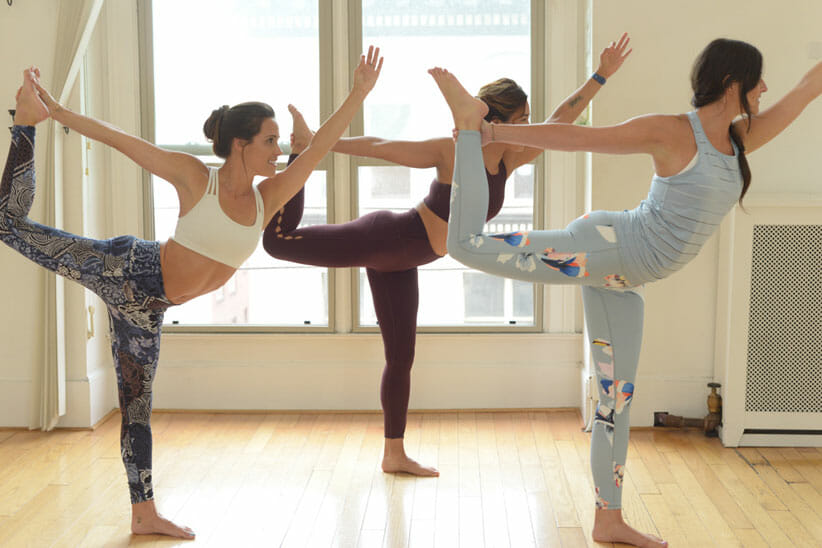
Sarah Ezrin and Students. Photo by Andy Blake.
Creating an Environment of Connection
Yoga teachers have the privilege and responsibility to help facilitate this coming together. The tone we set in our classes can create an environment of connection. This is one of the small ways we can give back to society at large — by helping to hold a space where people feel seen and where they feel safe to show themselves to others. We do not need to hold hands and sing “Kumbaya.” Building community in classes can be as simple as referring to the group as “yogis,” bonding individuals together in their common interest.
Yes, the world may feel increasingly divisive and yes, there are a lot of things trying to pull us apart. But there is a force that outpowers and outlasts any malevolence. That force is love. Let us help bring more love into this world, by helping bring people together!
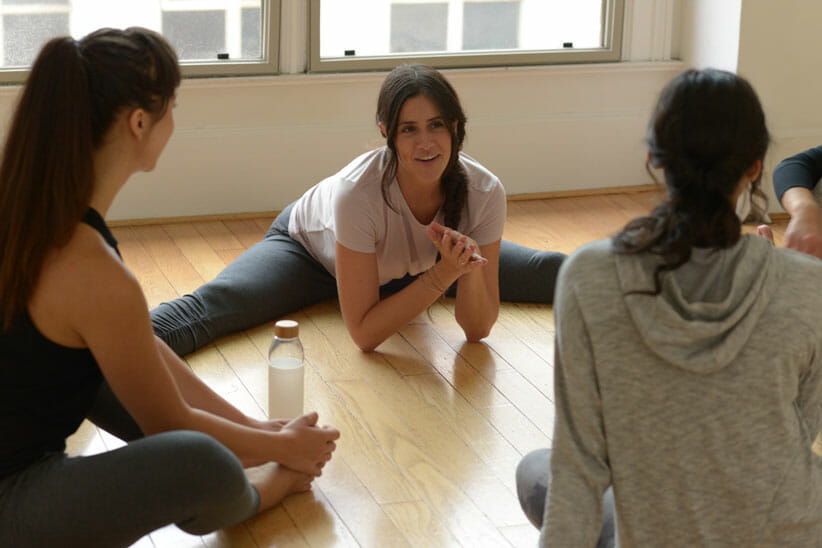
Sarah Ezrin and Students. Photo by Andy Blake.
Here are 5 ways to help build community in your yoga class.
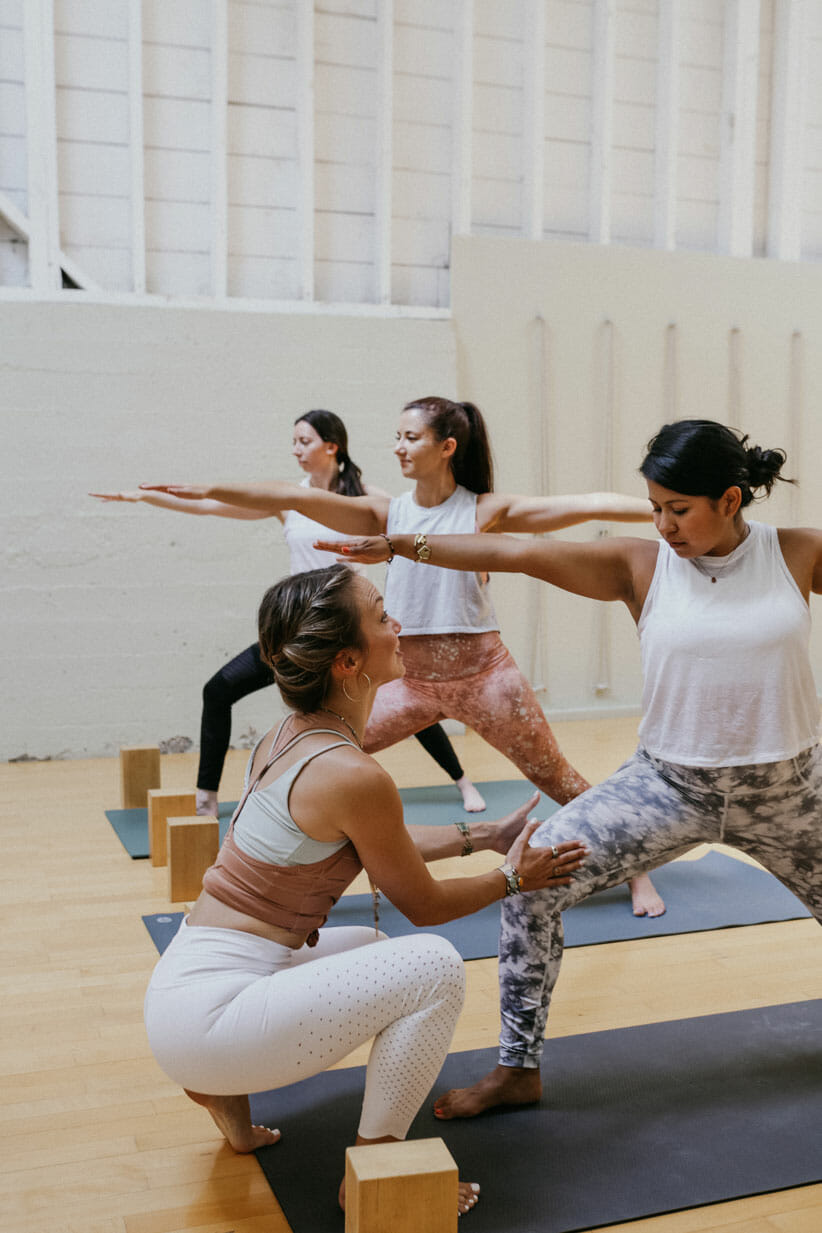
Maria LaValette and Attune + Align Students. https://marisalavalette.com/attune-align-yoga-teacher-training/
Learn people’s names.
Begin to see and honor individuals by name. This is a great way to help students feel that they belong. They are no longer strangers who just slip in and out of class. Students are seen. They are wanted. They are alive. When people are acknowledged it helps them feel a part of something. Once you know names you can use them to give people shout-outs in class. Some would argue that public praise reinforces an attachment to the practice or poses, but I am not referring to giving people compliments them every time they do some party trick. Instead, acknowledge effort or comprehension. Like when someone integrates a cue well or when they were incredibly focused in a pose.
Invite new students to introduce themselves to you.
At the end of every class, I re-introduce myself and encourage anyone new or who has been coming for a little while to come up and say “Hello.” This is one way I learn names, but it is also a way for people to feel welcome. I am often surprised how many people are willing to hang around for a moment to say hi. Even if I am speaking to another student, people wait patiently for their introduction. It is important in that moment to really be with that particular person. We can do this through eye contact and handshakes. It also helps to repeat the person’s name back to them. This will reinforce you learning names.
Have people introduce themselves to each other and add one fun fact.
I learned this from my teacher Annie Carpenter. Whenever her class is packed mat to mat, she asks students to introduce themselves to their neighbor. This way, if they bump into one another during practice, they are now friends. I have added onto this exercise over the years by having people include one fun fact. For example, if it is raining, I ask them to share what they love about the rain. It makes for an extra minute or so before class gets going, but what is more important—another vinyasa or building community?
Connect students to others with similar interests in or experiences.
As people become more frequent regulars, teachers have the honor of learning more about their students. My favorite thing to do before class is to connect people with common interests. Some of my best friends were made at yoga and I love being able to facilitate those kinds of friendships. For example, I have a number of teacher training students in my classes from my past and current trainings. I will often introduce them and watch the conversations flourish. You never know when you will meet someone who will change your life and how cool if it were in your class!
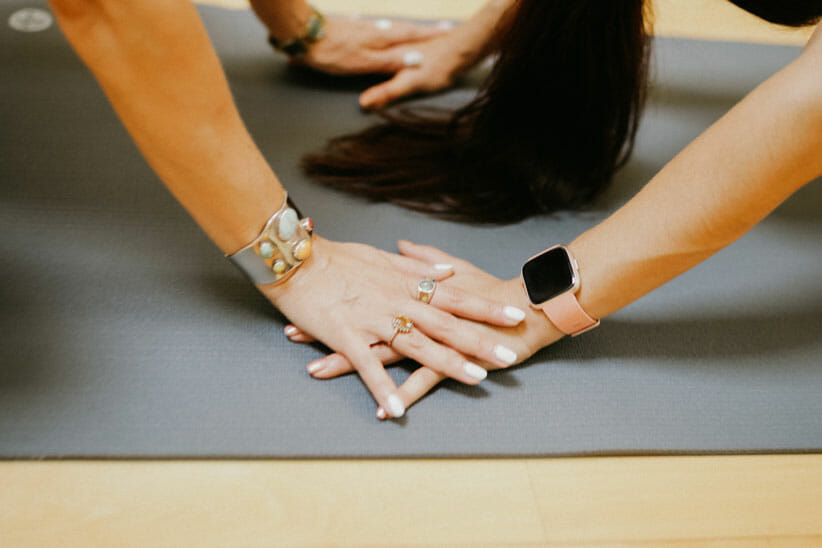
Marisa LaVette Attune + Align Teacher Training. https://marisalavalette.com/attune-align-yoga-teacher-training/
Explain “Namaste.”
Most yoga teachers end their class with the traditional salutation “Namaste” and most students repeat it back, but do they really know what they are saying? Every once in a while, I take the time to explain to the students what it is we are actually saying. “Namaste” comes from the same root as the word “namaskar” and means to bow. However, we are saying much more than “I bow to you”. What we are saying is “I see you and you see me”. Some teachers will translate the term as “The light in me bows to the light in you.” It is a recognition of the love inside all of us. An acknowledgement that underneath it all, we are the same. Remind students that this understanding is a way to build community.
Sarah Ezrin is the author of The Yoga of Parenting: Ten Yoga-Based Practices to Help You Stay Grounded, Connect with Your Kids, and Be Kind to Yourself. She is a freelance writer, yoga educator, and content creator based in the Bay Area. Her willingness to be unabashedly honest and vulnerable along with her innate wisdom, make her writing, teaching, and social media great sources of healing and connection for many people.
Sarah brings a wide spectrum of life experiences into everything she does. She is unafraid of sharing all sides of herself. She does so in the hope of giving others permission to be their most authentic self. At this time, when honest self-awareness is so important, Sarah’s is an essential and exemplary voice.
Sarah writes extensively on the subjects of yoga, parenting, and mental health, often interweaving these themes. Her work ranges from heavily-reported assignments to personal essays to blog content for brands. She is a regular contributor for Yoga Journal Magazine, Motherly, Yoga International, Healthline, Scary Mommy, Mind Body Green, Mantra Magazine, and LA Yoga Magazine. She has been featured in the Wall Street Journal, Forbes Magazine, Bustle, LA Weekly, and NBC News.
Sarah is a well-respected yoga teacher and a leader in the wellness community. A world traveler since birth, she has led trainings, workshops, and retreats locally and across the globe.
